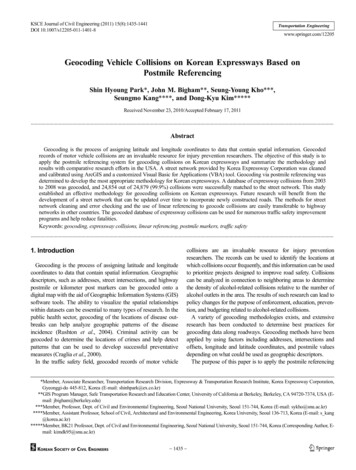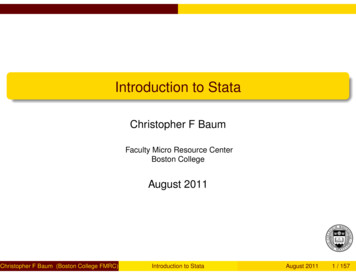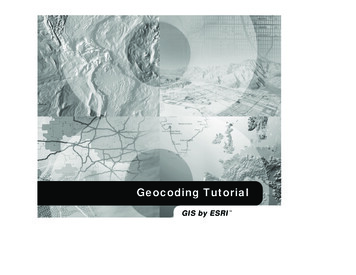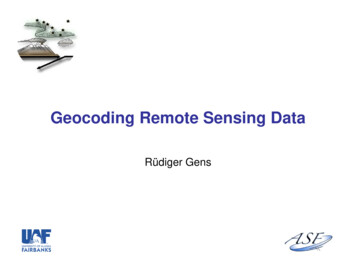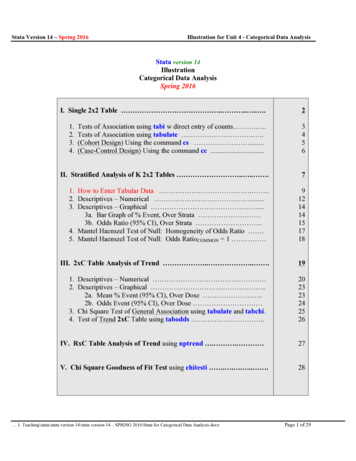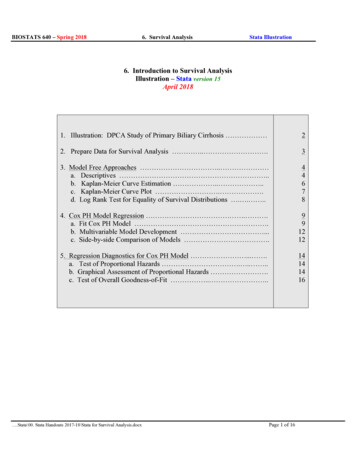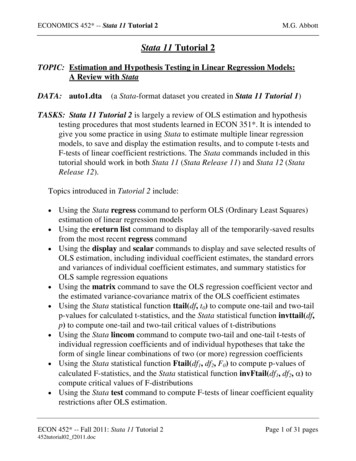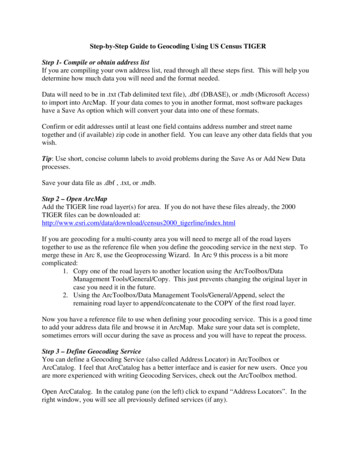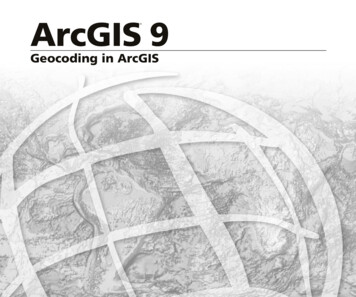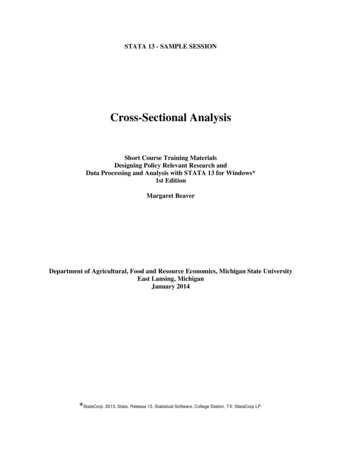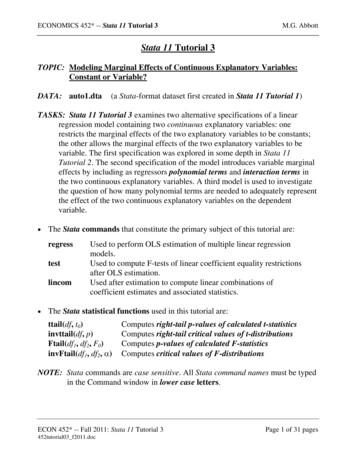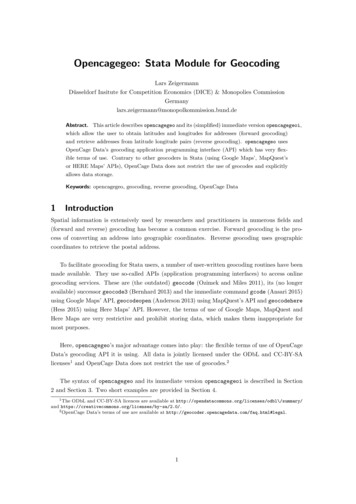
Transcription
Opencagegeo: Stata Module for GeocodingLars ZeigermannDüsseldorf Insitute for Competition Economics (DICE) & Monopolies .bund.deAbstract. This article describes opencagegeo and its (simplified) immediate version opencagegeoi,which allow the user to obtain latitudes and longitudes for addresses (forward geocoding)and retrieve addresses from latitude longitude pairs (reverse geocoding). opencagegeo usesOpenCage Data’s geocoding application programming interface (API) which has very flexible terms of use. Contrary to other geocoders in Stata (using Google Maps’, MapQuest’sor HERE Maps’ APIs), OpenCage Data does not restrict the use of geocodes and explicitlyallows data storage.Keywords: opencagegeo, geocoding, reverse geocoding, OpenCage Data1IntroductionSpatial information is extensively used by researchers and practitioners in numerous fields and(forward and reverse) geocoding has become a common exercise. Forward geocoding is the process of converting an address into geographic coordinates. Reverse geocoding uses geographiccoordinates to retrieve the postal address.To facilitate geocoding for Stata users, a number of user-written geocoding routines have beenmade available. They use so-called APIs (application programming interfaces) to access onlinegeocoding services. These are (the outdated) geocode (Ozimek and Miles 2011), its (no longeravailable) successor geocode3 (Bernhard 2013) and the immediate command gcode (Ansari 2015)using Google Maps’ API, geocodeopen (Anderson 2013) using MapQuest’s API and geocodehere(Hess 2015) using Here Maps’ API. However, the terms of use of Google Maps, MapQuest andHere Maps are very restrictive and prohibit storing data, which makes them inappropriate formost purposes.Here, opencagegeo’s major advantage comes into play: the flexible terms of use of OpenCageData’s geocoding API it is using. All data is jointly licensed under the ODbL and CC-BY-SAlicenses1 and OpenCage Data does not restrict the use of geocodes.2The syntax of opencagegeo and its immediate version opencagegeoi is described in Section2 and Section 3. Two short examples are provided in Section 4.1 The ODbL and CC-BY-SA licences are available at and https://creativecommons.org/licenses/by-sa/2.0/.2 OpenCage Data’s terms of use are available at http://geocoder.opencagedata.com/faq.html#legal.1
2Opencagegeo2.1Syntaxopencagegeo if in , key(string) number(varname) street(varname)postcode(varname) city(varname) county(varname) state(varname)country(varname) fulladdress(varname) latitude(varname) longitude(varname)coordinates(varname) countrycode(varname or string) language(varname or string) replace resume2.2OptionsGeneralkey (string) is required and specifies the OpenCage Data API key.countrycode (varname or string) specifies the country code. countrycode() allows either astring variable or a string as input.language (varname or string) specifies the language in which the results are returned. language()allows either a string variable or a string as input. The default is en for English.resume specifies that the process is continued after the rate limit was exceeded the day before.resume may not be combined with replace.Forward Geocodingnumber (varname) specifies the variable containing the house number.street (varname) specifies the variable containing the street. varname must be string.postcode (varname) specifies the variable containing the postal code.city (varname) specifies the variable containing the city, town or village. varname must bestring.county (varname) specifies the variable containing the county. varname must be string.state (varname) specifies the variable containing the state. varname must be string.country (varname) specifies the variable containing the country. varname must be string.fulladdress (varname) specifies a single variable containing some or all of the above options.2
varname must be string. fulladdress() may not be combined with any of the above options.Reverse Geocodinglatitude(varname) specifies the variable containing the latitude. Values must lie between -90and 90.longitude(varname) specifies the variable containing the longitude. Values must lie between-180 and 180.coordinates(varname) specifies the variable containing latitude longitude pairs. Latitudes mustlie between -90 and 90 and must be stated first. Longitudes must lie between -180 and 180.Both values must be separated by a comma. varname must be string. coordinates() maynot be combined with latitude() and longitude().2.3RemarksGeneralopencagegeo requires an OpenCage Data API key which can be obtained by signing up athttps://geocoder.opencagedata.com/users/sign up. The user can choose among a number of customer plans with different daily rate limits. The free trial plan allows 2.500 requests perday. If the rate limit is hit, opencagegeo will issue an error message and exit. To continue thetask on the following day, the user may simply add the resume option to the orignal specification.opencagegeo will automatically detect which observations are still to be geocoded. The useris strongly advised not to make any changes to the data until geocoding of all observations iscompleted.3 A new day begins at 00:00:00 Coordinated Universal Time (UTC).If the variables opencagegeo creates, see Section 2.4 below, already exist, the user can specify replace to overwrite existing observations. If either in or if is specified, only the selectedobservations will be replaced. resume and replace may not be combined.The countrycode() option allows the user to specify the country of the location. Providing a country code will restrict the results to the given country. If all locations lie in the samecountry, the user may enter the country code directly into countrycode(). Alternatively, if thelocations are in more than just one country, a variable containing the respective country codesneeds to be specified. The country code is a two letter code as defined by the ISO 3166-1 Alpha 2 standard.4 If any country code is invalid, opencagegeo will issue an error message and exit.The language() option allows the user to specify the language in which the results are re3 The resume option evaluates the output variable g quality to select observations which have not yet beengeocoded.4 A comprehensive list of all ISO 3166-1 Alpha 2 codes is available at https://www.iso.org/obp/ui/#search.3
turned. As with countrycode(), either a string or a string variable can be specified. The languagemust be entered in IETF format language code.5 The default is English. If the language is set tonative, the results will be returned in the native language of the location - provided the underlyingOpenStreetMap(OSM) data is available in that language. Users of Stata 13 or older are advisedto use the language() option carefully as many languages other than English contain specialcharacters which cannot be displayed properly.opencagegeo requires two user-written Stata libraries, insheetjson and libjson (Lindsley2012a,b), which are available at Statistical Software Components.Forward geocodingGenerally, there are two different ways of feeding addresses into opencagegeo. Firstly, by components using the street(), number(), postcode(), city(), county(), state() and country()options. This is recommended if the location address data is provided in separate variables. Notall options need to be specified at the same time; they can be combined in any meaningful way.To obtain geocodes of, let’s say, cities, you may use city(), state() and country().Secondly, if the address is contained in a single string variable, the fulladdress() option maybe employed. The address should follow the country specific conventions, although the OpenCageGeocoder allows for some flexibility. A well-formatted address could look like:”number street, city postal code, county, state, country””street number, postal code city, county, state, country”Generally, the OpenCage Geocoder is not case sensitive and can deal with commonly usedabbreviations. Running opencagegeo in Stata 14 (or newer) allows the address variables to bein Unicode (UTF-8). That is address names may contain accented characters, symbols and nonlatin characters. For older releases, the input variables must not contain any special characters.6Otherwise, opencagegeo will issue an error message and exit. opencagegeo is sensitive to spellingmistakes and will return empty strings for misspelled location addresses.Reverse geocodingAs with forward geocoding, two options are available for reverse geocoding. If longitudes and latitudes are contained in two separate variables, the latitude() and longitude() options shouldbe used.Alternatively, latitude longitude pairs may be fed into the coordinates() option. Latitudesneed to be stated first and both values must be separated by a comma.Latitudes must take values between -90 and 90 and longitudes must be between -180 and 180.5 A comprehensive list of all IETF language codes is available at gistry/language-subtag-registry.6 Only ASCII printable characters, i.e. character codes 32-127, may be used in the input variables.4
Otherwise, opencagegeo will issue an error message and exit.2.4Output variablesRunning opencagegeo generates a set of 12 variables, all having g prefixes.7g latitude and g longitude contain the latitudes and longitudes retrieved. The variablesg number, g street, g postcode, g city, g county, g state and g country contain the respective information returned. If the information is missing (e.g. the house number is not known)or not requested (number() was not specified or no information on the house number was contained in address variable fed into the fulladdress() option), an empty string for the respectivevariable will be returned. g formatted contains a well-formatted place name generated by theOpenCage Geocoder. In addition to the postal address, it might also have additional informationon the name of the building, institution, shop etc. at that location.Finally, g confidence and g quality are generated. The former provides a measure of precision of the match and is directly returned from the OpenCage Geocoder. The confidence valueis calculated as the distance in kilometres between the South-East and the North-West corners ofthe bounding box. Confidence levels are defined as follows:0 unable to determine bounding box1 25 km or more2 less than 25 km3 less than 20 km4 less than 15 km5 less than 10 km6 less than 7.5 km7 less than 5 km8 less than 1 km9 less than 0.5 km10 less than 0.25 km7The JSON paths used to extract the results returned from the OpenCage Geocoder are given in the appendix.5
The variable g quality contains the accuracy level of the returned results and is defined as follows:0 location not found1 country2 state3 county4 city5 postcode6 street7 numberIf, for example, the returned results for an address contains information down to the postalcode level, but the street and the house number were not found, the quality level will be postcode.The highest quality level to be reached is hence determined by the inputs; if the number()is not specified or no information on the house number is contained in the variable fed intofulladdress(), the highest quality level to be achieved is street.3Opencagegeoi3.1Syntaxopencagegeoi #location3.2RemarksThe immediate opencagegeoi takes its inputs from what is typed as arguments rather than fromdata stored in the memory. Instead of creating output variables it immediately displays the resultsin the output window.opencagegeoi requires the API key to be stored in a global macro mykey. The location to begeocoded is then directly entered after opencagegeoi. For forward geocoding, the input shouldbe well-formatted as described above. For reverse geocoding, opencagegeoi accepts a latitudelongitude pair. The latitude is entered first and both values must be separated by a comma.The user may also define a global macro language containing the IETF code of the languagein which the result shall be returned. The default is English. If the user sets the language tonative, the results are returned in the native language of the location. Users of Stata 13 or oldershould be aware that special characters cannot be displayed properly.3.3Saved resultsIn addition to displaying the well-formatted address returned from the OpenCage Geocoder andthe latitude and longitude values, opencagegeoi saves the following results to r().6
Macrosr(input)address as typed by userlatitudeconfidence level of resultr(lat)r(conf)4r(formatted) well-formatted address returned fromOpenCage rd GeocodingAs an example consider the addresses of five Goethe Institutes in Europe, Mexico and the UnitedStates.8 The data is displayed below. nMexico CityNew YorkParisRomeSW7 2PH06700100037511600198Exhibition RoadTonalaIrving PlaceAvenue d IenaVia Savoia5043301715UKMexicoUSAFranceItalyTo geocode the five locations given above, we specify opencagegeo as follows:. opencagegeo, key(YOUR-KEY-HERE) street(STREET) number(NUMBER) postcode(POSTCODE) country(COUNTRY)OpenCage geocoded 1 of 5(output omitted )OpenCage geocoded 5 of 5g 00100.00Total5100.00Data generated is jointly licensed under the ODbL and CC-BY-SA licenses.The output table produced by opencagegeo illustrates that four out of five addresses wereidentified at the highest quality level, i.e. number. For one location, the exact house number wasnot found and the resulting quality level is street.Reverse GeocodingNow, we want to reverse geocode the latitudes and longitudes generated above. First, we renamethe variables and then specify opencagegeo using latitude(), longitude() and the replace8 The Goethe Institute is a non-profit German cultural association promoting the German language, the addresses are obtained from https://www.goethe.de/en/wwt.html.7
option. rename g lat LATITUDE. rename g lon LONGITUDE. opencagegeo, key(YOUR-KEY HERE) latitude(LATITUDE) longitude(LONGITUDE) replaceOpenCage geocoded 1 of 5(output omitted )OpenCage geocoded 5 of 5g 00100.00Total5100.00Data generated is jointly licensed under the ODbL and CC-BY-SA licenses.Not surprisingly, we find that four latitude longitude pairs are identified at the number andone at the street level.4.2OpencagegeoiForward GeocodingIf we intend to geocode a single location only and want the results to be displayed in the outputwindow rather than saved as variables, we should use the immediate version opencagegeoi. Note,however, that we need to define a global macro mykey first.9. global mykey YOUR-KEY-HERETo obtain the geographic coordinates of the Goethe Institute London, we specify opencagegeoias following:. opencagegeoi 50 Exhibition Road, London SW7 2PH, UK************************************ OpenCage Geocoder Results ************************************Formatted address: Goethe Institute, 50-51 Exhibition Road, London SW7 1BF, UKLatitude: 51.4994811Longitude: -0.174013268370617Reverse GeocodingTo retrieve the postal address from geographic coordinates - in our example of the Goethe Institutein London - we type:. opencagegeoi 51.4994811,-0.1740132683706179 Theglobal macro mykey needs to be specified only once when a new Stata window is opened.8
************************************ OpenCage Geocoder Results ************************************Formatted address: Goethe Institute, 50-51 Exhibition Road, London SW7 1BF, UKLatitude: 51.4994811Longitude: -0.1740132683706175AppendixThe OpenCage Geocoder API returns its results in JSON (JavaScript Object Notation) format.The respective information is then extracted and stored in the variables described above (ordisplayed immediately in the case of opencagegeoi). As the underlying data (provided by OpenStreetMap (OSM) and other open data sources) is maintained by many contributors, keys are notuniquely defined. The key leading to, let’s say, the street name is not always street, but may bestreet name, road etc. instead. Unfortunately, there exists no exhaustive list of all these aliases,however, opencagegeo uses the most common ones to generate its output variables.10 The socalled JSON paths which are used for extracting the data are reported in the table below.VariableJSON path(aliases)g latituderesults:1:geometry:latg longituderesults:1:geometry:lngg streetresults:1:components:streetg numberg postcodeg city(street name, road, residential, footway, pedestrian)results:1:components:house nents:city(town, village, hamlet)g countyresults:1:components:countyg stateresults:1:components:stateg countryresults:1:components:countryg formattedresults:1:components:formattedg confidenceresults:1:components:confidenceThe JSON paths used by opencagegeoi are the same as for the respective variables generatedby opencagegeo.6AcknowledgementsI would like to thank Ed Freyfogle of OpenCage Data for his support and Achim Ahrens fortesting opencagegeo and helping improve it. I also thank the authors of the existing geocoding10 If none of the keys used by opencagegeo lead to the requested information, an empty string in the respectivevariable will be returned. However, the information will be part of the well-formatted address in g formatted.9
routines for Stata, especially Adam Ozimek and Daniel Miles (geocode). Parts of opencagegeobuild upon their code. The immediate version was added at Kit Baum’s suggestion. All remainingerrors are my own. Comments and suggestions are welcome.7ReferencesAnderson, M. 2013. GEOCODEOPEN: Stata module to geocode addresses using MapQuestOpen Geocoding Services and Open Street Maps Ansari, M. R. 2015. GCODE: Stata module to download Google geocode data Bernhard, S. 2013. GEOCODE3: Stata module to retrieve coordinates or addresses from GoogleGeocoding API Version 3 .Hess, S. 2015. GEOCODEHERE: Stata module to provide geocoding relying on Nokias HereMaps API Lindsley, E. 2012a. INSHEETJSON: Stata module for importing tabular data from JSON sourceson the internet https://ideas.repec.org/c/boc/bocode/s457407.html. 2012b. LIBJSON: Stata module to provide Mata class library for obtaining and parsingJSON strings into object trees Ozimek, A., and D. Miles. 2011. Stata utilities for geocoding and generating travel time andtravel distance information. The Stata Journal 11(1): pp. 106–119.10
Keywords: opencagegeo, geocoding, reverse geocoding, OpenCage Data 1 Introduction Spatial information is extensively used by researchers and practitioners in numerous elds and (forward and reverse) geocoding has become a common exercise. Forward geocoding is the pro-cess of converting an address into geographic coordinates.
